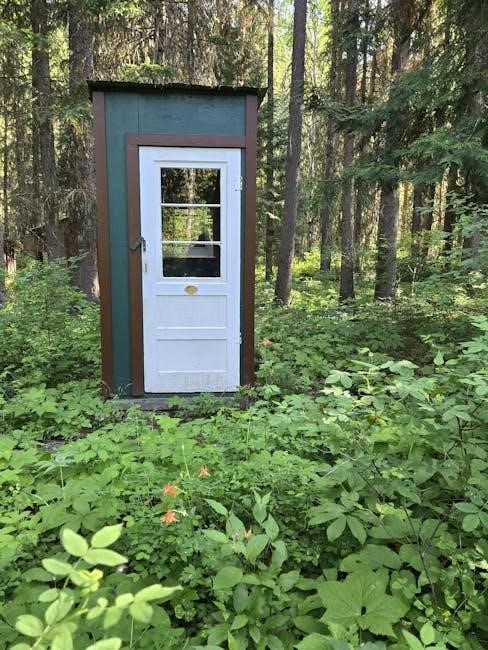Door closers ensure smooth, controlled door operation, preventing slamming and ensuring proper latching. They are essential for safety, accessibility, and energy efficiency in commercial and residential settings.
What is a Door Closer?
A door closer is a mechanical or hydraulic device designed to automatically close doors after they have been opened. It ensures smooth operation by controlling the closing speed and force, preventing slamming. Typically mounted on the door or door frame, it consists of a piston, cylinder, and spring mechanism. The closer provides consistent closure, ensuring proper latching and security. It is commonly used in commercial settings but is also popular in residential applications. Door closers are essential for maintaining accessibility, reducing noise, and enhancing safety. They come in various types, including surface-mounted, concealed, and overhead models, each suited for different door configurations and requirements.
Importance of Proper Adjustment
Proper adjustment of a door closer ensures smooth, controlled door closure, preventing issues like slamming or failure to latch. Incorrect settings can lead to safety hazards, increased wear on door components, and compromised accessibility. By fine-tuning the closing speed, latching speed, and backcheck, you ensure the door operates efficiently, providing consistent performance over time. Proper adjustment also maintains compliance with fire safety and accessibility standards, ensuring safe evacuation routes and equal access for all users. Regular adjustments extend the lifespan of the door closer, reducing maintenance needs and enhancing overall functionality. Accurate calibration is key to balancing security, convenience, and safety in any setting.
Tools and Equipment Needed
Essential tools include a screwdriver, hex key, or Allen wrench for adjustments, along with a ladder for high-mounted closers. Additional items like a wrench or measuring tape may be needed.
Essential Tools for Adjustment
Adjusting a door closer requires specific tools to ensure precision and safety. A screwdriver or hex key is necessary for turning adjustment screws, while an Allen wrench may be needed for certain models. For high-mounted closers, a sturdy ladder is essential to reach the adjustment points safely. Additionally, an adjustable wrench can help with tension adjustments, and a measuring tape or pencil might be useful for marking positions. Ensure all tools are readily available before starting the adjustment process to avoid delays. The right tools will help achieve the desired closing speed and latching force, ensuring smooth and proper door operation. Properly equipping yourself with these tools is key to successful adjustments.

Installation Instructions
Mount the door closer securely, following the manufacturer’s instructions for positioning and alignment. Use provided screws to attach the closer to the door frame or jamb, ensuring proper functionality.
Standard Installation Method
Begin by positioning the door closer on the door frame, aligning it with the hinge side for optimal performance. Secure it using the screws provided, ensuring a tight fit. Next, attach the closer arm to the door, making sure it is properly aligned to avoid any functionality issues. Adjust the arm’s length if necessary to achieve smooth operation. Finally, test the door to ensure it closes smoothly and latches securely, making any minor adjustments as needed for optimal performance.
Top Jamb Installation Method
The top jamb installation method involves mounting the door closer on the door frame above the door, rather than on the door itself. Begin by marking the frame according to the manufacturer’s template, ensuring proper alignment. Secure the closer using the provided screws, making sure it is tightly fastened. Attach the closer arm to the door, adjusting its length to ensure smooth operation. Fine-tune the adjustment screws to control the closing speed and latching force. Test the door to confirm it closes evenly and latches securely. This method is ideal for heavy-duty doors and provides a sleek, concealed appearance. Always refer to the manufacturer’s instructions for specific details, as configurations may vary.

Adjusting the Door Closer
- Locate the adjustment screws on the door closer.
- Turn screws counterclockwise to increase speed or force.
- Turn screws clockwise to decrease speed or force.
- Test the door after each adjustment.
Minor adjustments can significantly improve door functionality.
Adjusting the Closing Speed
To adjust the closing speed of a door closer, locate the main speed adjustment valve, typically marked with an “S” or a label. Use a screwdriver or Allen wrench to make precise adjustments. Turning the valve counterclockwise increases the closing speed, while clockwise decreases it. Start with small adjustments, such as 1/8 of a turn, and test the door’s movement after each change. Over-tightening can lead to excessive force, so proceed cautiously. Ensure the door closes smoothly and evenly without slamming. Proper adjustment ensures safety, energy efficiency, and compliance with fire safety standards. Always refer to the manufacturer’s instructions for specific guidance on your door closer model.
Adjusting the Latching Speed
Adjusting the latching speed ensures the door securely latches without slamming. Locate the latch speed adjustment valve, often labeled with an “L.” Use a screwdriver or Allen wrench to make fine-tuned adjustments. Turning the valve counterclockwise increases the latching speed, while clockwise decreases it. Small adjustments, such as 1/8 of a turn, are recommended to avoid over-tightening. Test the door’s latching action after each adjustment to ensure it closes firmly yet gently. Proper latching speed prevents gaps and enhances security. Refer to the manufacturer’s instructions for specific guidance, as different models may vary. This adjustment is crucial for maintaining door functionality and longevity, ensuring it meets safety and operational standards.
Adjusting the Backcheck
Adjusting the backcheck prevents the door from opening too widely and damaging surrounding structures. Locate the backcheck adjustment screw or valve, typically marked with a “B.” Use a screwdriver or Allen wrench to modify the setting. Turning the screw counterclockwise increases resistance, limiting the door’s opening range, while clockwise decreases it. Small adjustments, such as 1/8 of a turn, are recommended to achieve the desired control. Test the door’s movement after each adjustment to ensure it opens smoothly but does not overextend. Proper backcheck adjustment protects the door, frame, and adjacent walls from impact damage. Always consult the manufacturer’s instructions for specific guidance, as mechanisms may vary. This adjustment ensures safe and efficient door operation, preventing unnecessary wear and tear.
Adjusting the Delayed Action
Adjusting the delayed action on a door closer involves modifying the timing mechanism that controls how long the door remains open before starting to close. This feature is typically found in specialized door closers designed for environments requiring extended door-holding functionality, such as hospitals or public buildings; To adjust the delayed action, locate the specific adjustment screw or valve, often labeled with a “D” or similar designation. Turning the screw counterclockwise usually increases the delay time, while clockwise decreases it. Small adjustments of 1/8 turn are recommended to fine-tune the timing without overcompensating. Test the door’s response after each adjustment to ensure it aligns with your needs. Proper adjustment ensures the door holds open long enough for safe passage but closes promptly to maintain security and energy efficiency. Always refer to the manufacturer’s guidelines for precise instructions, as mechanisms can vary. This adjustment enhances accessibility and convenience while maintaining functional door operation.

Troubleshooting Common Issues
Common door closer issues include slow closing, excessive force, and failure to latch. Adjusting screws, cleaning, or lubricating moving parts often resolve these problems. Consult a professional if issues persist.
Addressing Slow Closing Issues
If a door closes too slowly, it may not latch properly, leading to security risks. To address this, locate the adjustment screws on the door closer. Turning the speed valve counterclockwise increases the closing force, while a clockwise turn decreases it. Make small adjustments, about 1/8 of a turn, and test the door’s speed after each change. Ensure the door closer is properly lubricated, as friction can slow it down. Additionally, check for worn-out parts or hydraulic fluid leaks, which may require professional attention. Always refer to the manufacturer’s instructions for specific guidelines, as different models may vary in adjustment mechanisms.
Resolving Excessive Closing Force
If a door closes with excessive force, it can damage the door frame or pose a safety hazard. To resolve this, locate the main speed valve on the door closer. Turn the adjustment screw clockwise to reduce the closing force. Make small adjustments, about 1/8 of a turn, and test the door’s operation after each change. If the issue persists, check for over-tightened springs or worn-out components. Proper lubrication of moving parts can also help reduce friction and regulate the closing force. Ensure the door closer is installed correctly and aligned with the door frame. If the problem remains, consult the manufacturer’s instructions or seek professional assistance to avoid further damage or safety risks.
Fixing a Door That Doesn’t Latch
If a door fails to latch properly, it can compromise security and functionality. Inspect the door closer’s latch speed adjustment, typically controlled by a designated valve. Turn the adjustment screw counterclockwise to increase the latching force, ensuring the door shuts firmly. Check the alignment of the strike plate and door frame; misalignment can prevent latching. Adjust the door closer’s position or tighten loose screws if necessary. Ensure the door closer is lubricated to maintain smooth operation. If the door still doesn’t latch, inspect for worn-out parts, such as the piston or cylinder, and replace them as needed. Proper adjustment and maintenance can restore the door’s ability to latch securely, ensuring optimal performance and safety.

Maintenance Tips
Regularly clean the door closer to remove dirt and debris. Lubricate moving parts with silicone-based oil to ensure smooth operation and prevent wear and tear over time.
Cleaning the Door Closer
Regular cleaning is essential for maintaining the functionality and appearance of a door closer. Start by wiping the surface with a soft cloth to remove dust and dirt. For tougher grime, use a mild detergent solution, avoiding harsh chemicals or abrasive cleaners that could damage the finish. Gently scrub the exterior, paying attention to crevices where debris may accumulate. Rinse with a damp cloth and dry thoroughly to prevent water spots. Never submerge the door closer in water or expose it to excessive moisture, as this can compromise its internal mechanisms. By keeping the door closer clean, you ensure optimal performance and extend its lifespan. Regular maintenance also helps prevent corrosion and keeps the door operating smoothly.
Lubricating Moving Parts
Lubricating the moving parts of a door closer is crucial for ensuring smooth operation and extending its lifespan. Use a high-quality silicone-based lubricant, as it resists dust and dirt buildup. Apply a small amount to the hinge pins, piston, and cylinder connections. Avoid using oil or grease, as they can attract contaminants. For hydraulic door closers, lubricate the arm and shaft where they connect to the cylinder. Repeat this process every 6-12 months or when you notice increased resistance or noise. Over-lubrication can lead to residue accumulation, so use it sparingly. Regular lubrication reduces friction, prevents corrosion, and ensures the door closes evenly and quietly. Always test the door after lubrication to confirm proper functionality.
Fire Safety Considerations
Door closers must comply with fire safety standards to ensure proper function during emergencies. Proper adjustment ensures doors close securely, preventing fire spread. Regular testing and professional adjustment are critical. Firesafety-compliant door closers must be installed and maintained according to local regulations. Use closers certified to EN 1154 or equivalent standards. Smoke detectors can trigger door closures in emergencies. Always ensure door closers are compatible with fire-rated doors. Proper installation and adjustment are vital for fire safety. Follow manufacturer guidelines and local codes to maintain compliance. Regular inspections ensure reliable operation. Fire safety is non-negotiable, and door closers play a key role in protecting lives and property.
Ensuring Compliance with Fire Safety Standards
Ensuring compliance with fire safety standards is critical for door closers in buildings. Door closers must be installed and adjusted according to local fire regulations and international standards like DIN EN 1154. Proper adjustment ensures doors close securely, preventing fire spread. Fire-rated doors require compatible door closers certified for fire safety. Regular inspections and maintenance by professionals are essential to maintain compliance. Adjustments should not compromise the door’s ability to close fully and latch securely. Smoke detectors and fire alarms often integrate with door closers to ensure automatic closure during emergencies. Non-compliance can lead to safety risks and legal penalties. Always use closers designed for fire-rated applications and follow manufacturer guidelines for installation and adjustment. Proper compliance ensures reliable performance in emergencies, protecting lives and property. Regular testing and certification are also required to maintain fire safety standards. Always prioritize fire safety when adjusting door closers.
Properly adjusting a door closer is essential for ensuring smooth operation, safety, and longevity. By following the steps outlined in this guide, you can fine-tune closing speeds, latching speeds, and backcheck mechanisms to meet specific needs. Regular maintenance, including cleaning and lubrication, will keep your door closer functioning optimally. Always use appropriate tools and refer to manufacturer instructions for precise adjustments. Troubleshooting common issues like slow closing or excessive force can be resolved with minor tweaks. Compliance with fire safety standards is non-negotiable, ensuring doors perform reliably in emergencies. By mastering door closer adjustments, you enhance accessibility, energy efficiency, and overall security. Remember, small adjustments can make a significant difference in performance. Apply the knowledge from this guide to ensure your doors operate smoothly and safely for years to come.

